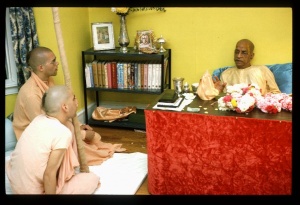CC Adi 2.29: Difference between revisions
m (1 revision(s)) |
No edit summary |
||
| Line 1: | Line 1: | ||
{{ | [[Category:Sri Caitanya-caritamrta - Adi-lila Chapter 02|C029]] | ||
<div style="float:left">'''[[Sri Caitanya-caritamrta|Śrī Caitanya-caritāmṛta]] - [[CC Adi|Ādi-līlā]] - [[CC Adi 2|Chapter 2: Śrī Caitanya Mahāprabhu Is the Supreme Personality of Godhead]]'''</div> | |||
<div style="float:right">[[File:Go-previous.png|link=CC Adi 2.28|Ādi-līlā 2.28]] '''[[CC Adi 2.28|Ādi-līlā 2.28]] - [[CC Adi 2.30|Ādi-līlā 2.30]]''' [[File:Go-next.png|link=CC Adi 2.30|Ādi-līlā 2.30]]</div> | |||
{{CompareVersions|CC|Adi 2.29|CC 1975|CC 1996}} | |||
{{RandomImage}} | |||
==== TEXT 29 ==== | ==== TEXT 29 ==== | ||
<div | <div class="verse"> | ||
iṅhota dvi-bhuja, tiṅho dhare cāri hātha | :iṅhota dvi-bhuja, tiṅho dhare cāri hātha | ||
iṅho veṇu dhare, tiṅho cakrādika sātha | :iṅho veṇu dhare, tiṅho cakrādika sātha | ||
</div> | </div> | ||
| Line 12: | Line 16: | ||
==== SYNONYMS ==== | ==== SYNONYMS ==== | ||
<div | <div class="synonyms"> | ||
''iṅhota''—this one; ''dvi-bhuja''—two arms; ''tiṅho''—He; ''dhare''—manifests; ''cāri''—four; ''hātha''—hands; ''iṅho''—this one; ''veṇu''—flute; ''dhare''—holds; ''tiṅho''—He; ''cakra-ādika''—the wheel, etc.; ''sātha''—with. | |||
</div> | </div> | ||
| Line 19: | Line 23: | ||
==== TRANSLATION ==== | ==== TRANSLATION ==== | ||
<div | <div class="translation"> | ||
This Personality of Godhead [Śrī Kṛṣṇa] has two hands and holds a flute, whereas the other [Nārāyaṇa] has four hands, with conch, wheel, mace and lotus. | This Personality of Godhead [Śrī Kṛṣṇa] has two hands and holds a flute, whereas the other [Nārāyaṇa] has four hands, with conch, wheel, mace and lotus. | ||
</div> | </div> | ||
| Line 26: | Line 30: | ||
==== PURPORT ==== | ==== PURPORT ==== | ||
<div | <div class="purport"> | ||
Nārāyaṇa is identical to Śrī Kṛṣṇa. They are in fact the same person manifested differently, like a high-court judge who is differently situated in his office and at home. As Nārāyaṇa the Lord is manifested with four hands, but as Kṛṣṇa He is manifested with two hands. | Nārāyaṇa is identical to Śrī Kṛṣṇa. They are in fact the same person manifested differently, like a high-court judge who is differently situated in his office and at home. As Nārāyaṇa the Lord is manifested with four hands, but as Kṛṣṇa He is manifested with two hands. | ||
</div> | </div> | ||
__NOTOC__ | |||
<div style="float:right; clear:both;">[[File:Go-previous.png|link=CC Adi 2.28|Ādi-līlā 2.28]] '''[[CC Adi 2.28|Ādi-līlā 2.28]] - [[CC Adi 2.30|Ādi-līlā 2.30]]''' [[File:Go-next.png|link=CC Adi 2.30|Ādi-līlā 2.30]]</div> | |||
__NOTOC__ | |||
__NOEDITSECTION__ | |||
Revision as of 18:43, 16 July 2021
Śrī Caitanya-caritāmṛta - Ādi-līlā - Chapter 2: Śrī Caitanya Mahāprabhu Is the Supreme Personality of Godhead

His Divine Grace
A.C. Bhaktivedanta Swami Prabhupada
A.C. Bhaktivedanta Swami Prabhupada
TEXT 29
- iṅhota dvi-bhuja, tiṅho dhare cāri hātha
- iṅho veṇu dhare, tiṅho cakrādika sātha
SYNONYMS
iṅhota—this one; dvi-bhuja—two arms; tiṅho—He; dhare—manifests; cāri—four; hātha—hands; iṅho—this one; veṇu—flute; dhare—holds; tiṅho—He; cakra-ādika—the wheel, etc.; sātha—with.
TRANSLATION
This Personality of Godhead [Śrī Kṛṣṇa] has two hands and holds a flute, whereas the other [Nārāyaṇa] has four hands, with conch, wheel, mace and lotus.
PURPORT
Nārāyaṇa is identical to Śrī Kṛṣṇa. They are in fact the same person manifested differently, like a high-court judge who is differently situated in his office and at home. As Nārāyaṇa the Lord is manifested with four hands, but as Kṛṣṇa He is manifested with two hands.